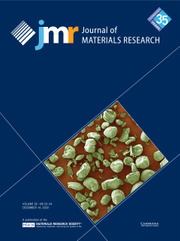Article contents
Surface treatment of titanium by anodization and iron deposition: mechanical and biological properties
Published online by Cambridge University Press: 26 May 2020
Abstract

Surface modification of titanium and titanium alloys is a common method to improve anchoring of bone tissue and implants in hard tissue engineering applications. In the current work, a combination of chemical and physical methods (anodization and physical vapor deposition) was used to roughen the titanium surface and deposit iron (Fe) on the surface of titanium at different thicknesses. The optimized thickness of 100 Å was selected for mechanical and biological characterization. We found that anodization increases the surface roughness of Ti from 21 ± 0 to 229 ± 9 nm, whereas Fe deposition does not change it significantly. Our results also showed that surface modification of Ti by anodization increases the proliferation of osteosarcoma cells at both time points, whereas Fe-deposited samples showed the lowest cellular activity. These results suggest that Fe-deposited Ti implants may be suitable candidates for patients with osteosarcoma, as the proliferation of malignant cells decreases in the presence of Fe.
Keywords
Information
- Type
- Article
- Information
- Copyright
- Copyright © Materials Research Society 2020
References
- 3
- Cited by

